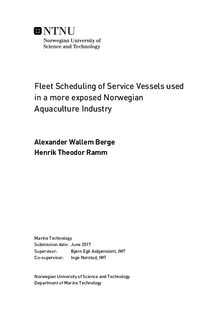| dc.description.abstract | This thesis studies a maritime transportation problem for service vessels used in the Norwegian aquaculture industry. We create an optimization model which try to find the most efficient fleet size and mix and associated routes in order to meet a specific demand for maintenance. A simulation model is used to evaluate if the routes are realistic.
The system which is modelled consists of several types of maintenance operations which are common in today's aquaculture industry. These are delousing, cleaning operations, handling of moorings, inspections, change of nets and transfer of personnel. The jobs are typically performed by three different vessel types, 15 m catamarans, 25 m catamarans or 40 m monohulls. In addition to today's industry, the thesis discusses possible future scenarios for service vessels which are handling of waste, sea grass farming and tourism.
The need for better production environment and increased production area have caused fish farmers to move their facilities towards more exposed locations. In order to reduce the risk of delays and increase the operational window for maintenance operations, vessels with better seakeeping abilities are necessary. Such vessels involve increased investment and operational costs.
More advanced vessels increases the demand for more efficient routing. Performing jobs in a suboptimal order will lead to unnecessary costs regarding fuel consumption, salary for crew members and dead time. Furthermore, varying weather conditions increases the need for better planning in order to avoid aborting operations. By investigating how the likelihood of vessels not being able to perform their jobs varies with different weather scenarios, we see how the planning process is affected.
The thesis uses a route generation algorithm combined with a set partitioning model to solve the optimization problem and find optimal fleets and routes for the given scenario. The route generation algorithm finds all possible routes based on constraints regarding vessel type and time windows. The possibility of implementing different weather scenarios is also included.
The weather is based on wave data from a buoy placed outside of Frøya in Sør-Trøndelag. Different weather scenarios are created by the use of Markov chain simulations. The weather conditions varies between 10 states representing different significant wave heights.
The simulation model evaluates how the routes suggested by the optimization model perform when different weather scenarios are generated. The model created is generic. The vessels used, routes travelled and jobs performed are all defined from an excel sheet which is used as input to the simulation model. By studying results from the simulation model we see how each route performs and how many jobs are executed within their time windows.
The simulation model is run with both calm and rough weather. By including rough weather, the robustness which is defined as number of jobs performed within their given time windows, decreases by 18% compared to the simulation with calm weather.
We test three different approaches which could increase the robustness of the optimization model. These are:
- Including weather constraints in the route generation algorithm.
- Setting a limit regarding how many jobs are allowed on each route.
- Including slack in the route generation algorithm.
The two methods showing most promising results are maximum number of jobs per route and slack. Implementing the methods separately lead to an increase in robustness by 7% and 3%, respectively. The cost increases are only 1% and 2%, respectively. By combining the two constraints we are able to increase the performance by 8% compared to not including any constraints. However, we see that even with these additional constraints included some of the routes are quite exposed to delays and additional actions might be necessary.
Further work regarding this topic should be directed towards better modelling of the real life scenarios. In order for the method to be more attractive to the industry, the algorithms used need to be more effective in order to be able to solve larger problem instances. In addition, the models need to represent the daily operations of the vessels in a more realistic way. | |

